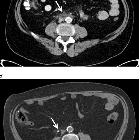Morbus Ormond




Idiopathic retroperitoneal fibrosis, also known as Ormond disease, is a subtype of retroperitoneal fibrosis where no obvious cause is found. It includes a spectrum of diseases which are characterized by fibroinflammatory tissue encasing the abdominal aorta and the iliac arteries. This process may extend into the retroperitoneum often enveloping the adjacent structures e.g. ureters.
Epidemiology
Retroperitoneal fibrosis in general is an uncommon condition with an estimated incidence of about 1.38 cases per 100,000 people ; of these ~70% cases are idiopathic.
Associations
Reported associations include
- primary biliary cholangitis
- fibrosing mediastinitis
- glomerulonephritis
- panhypopituitarism
- rheumatoid arthritis
- ankylosing spondylitis
- polyarteritis nodosa
- systemic lupus erythematosus (SLE)
- Hashimoto thyroiditis
Pathology
This inflammatory pathology is thought to arise as an autoimmune response to ceroid which leaks out of the atherosclerotic plaques and causes vasculitis. It is seen in association with other autoimmune processes, suggesting the possibility of an underlying autoimmune pathology.
Radiographic features
Contrast-enhancing fibrosis encompassing the retroperitoneal structures causing ureteric and vascular obstruction and displacement is seen with no other demonstrable alternative conditions or malignancy.
Recently contrast enhancing pericoronary tissue proliferations (mistletoe sign) have also been reported in some patients.
Treatment and prognosis
Complications such as acute renal failure secondary to periureteral involvement require prompt intervention. Treatment usually involves corticosteroids with or without other immunomodulating medications or tamoxifen. In the presence of periureteral or perivascular involvement, surgical intervention may be necessary.
History and etymology
The disorder was first described in 1905 by the French urologist Joaquin Albarran (1860-1912) and later first described in the English literature in 1948 by the American urologist John Kelso Ormond (1886-1978) .
Siehe auch:
- retroperitoneale Tumoren
- retroperitoneales Hämatom
- inflammatory abdominal aortic aneurysm
- primäre intestinale Lymphangiektasie
- Retroperitonealfibrose nach EVAR
- retroperitoneale Fibrose allgemein
- chronische Periaortitis
und weiter:

 Assoziationen und Differentialdiagnosen zu Morbus Ormond:
Assoziationen und Differentialdiagnosen zu Morbus Ormond:




